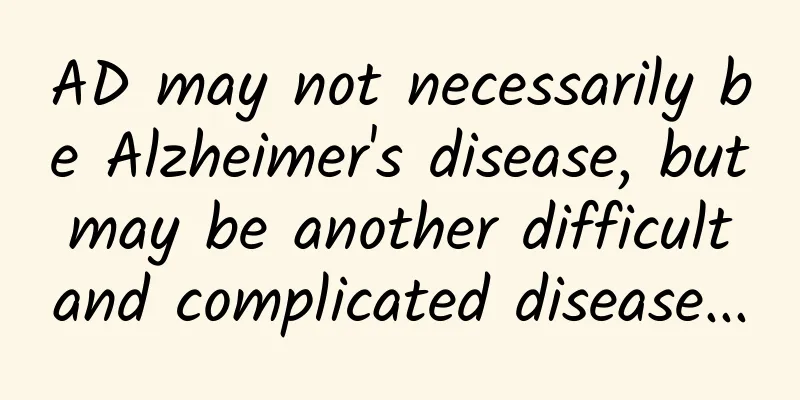AD may not necessarily be Alzheimer's disease, but may be another difficult and complicated disease...

|
What strange diseases have you heard of? Let's not talk about rare diseases such as ALS, albinism, and acromegaly. Have you heard of AD? A friend of mine has it. When it comes to AD, you may be surprised that such a young person can get AD. You may think of the familiar Alzheimer's disease, but this AD is not the same as that AD. This is the abbreviation of the disease Atopic Dermatitis, and its Chinese name is atopic dermatitis. Let's talk about this disease today. 01. Atopic dermatitis Atopic dermatitis. Many people may still feel unfamiliar with the name, but in fact, this disease is not a rare disease. It is a skin disease that troubles countless people and is one of the most common types of skin diseases. Atopic dermatitis is very prevalent among the population, with hundreds of millions of people worldwide suffering from this disease [1]. It is a chronic, recurrent inflammatory skin disease characterized by severe itching, often accompanied by other atopic diseases (such as asthma and allergic rhinitis). Imagine that AD, which troubles hundreds of millions of people worldwide, seriously affects the normal work and life of patients. They are usually so itchy that they cannot sleep well. Even if they fall asleep, the skin damage caused by scratching makes them toss and turn in pain, and a full night's sleep becomes an unattainable luxury. It can be said that atopic dermatitis that is not effectively controlled is almost always challenging the patient's physical, emotional and psychological state. Unfortunately, however, just like with Alzheimer's disease, we currently lack effective and safe treatments for atopic dermatitis. Currently, doctors treat atopic dermatitis mostly by following the conventional prescriptions for most skin diseases. One method is to prescribe topical hormones to patients for the treatment of local atopic dermatitis; the other method is to use systemic treatments such as immunosuppressants or oral corticosteroids for the treatment of systemic atopic dermatitis. However, these two treatment prescriptions themselves also have certain problems. The former is an external hormone, which can often only be used for milder dermatitis and cannot be used for a long time, because the skin's tolerance is not unlimited. Long-term use will cause skin damage and even cause new diseases. Although the latter is more effective, this systemic indiscriminate treatment may also cause serious side effects. In addition, the patient's own irregular medication, dependence on drugs, and personal lifestyle problems will further aggravate the difficulty of treating atopic dermatitis. As a result, atopic dermatitis has become a difficult and complicated disease, and therefore it has also supported many magical hospitals-various xx dermatology hospitals in various places. I believe everyone is very familiar with this. After all, most of them belong to the Putian system that has been revealed. In this case, if we can find a drug that can take both into account, it will undoubtedly be a blessing for hundreds of millions of atopic dermatitis patients around the world. However, it is difficult! Because we have not figured out the mechanism of atopic dermatitis! 02. How to develop new drugs? If we don’t know the mechanism, we can’t develop drugs? The answer is of course no. In fact, through research over the years, we have gained a certain understanding of atopic dermatitis, and researchers have a certain degree of confidence in developing drugs. Through observation, researchers discovered some of the characteristics of AD - immunity. Atopic dermatitis is also an inflammatory disease. Since it is an inflammation, it must be related to immunity. This was the earliest and boldest hypothesis of researchers about AD a long time ago. After careful verification, this was also confirmed. In the pathogenesis of atopic dermatitis, two important inflammatory factors are involved in this process, namely interleukin-13 (IL-13) and interleukin-4 (IL-4). These two are common factors in inflammation. In atopic dermatitis, antigens trigger type 2 immunity, which activates type 2 helper T cells and releases IL-13 and IL-4. These factors further cause immune responses [2]. For this reason, researchers have come up with a treatment for atopic dermatitis, which is to inhibit IL-13 and IL-4. For example, Sanofi has developed a biological agent Dupilumab, which is a monoclonal antibody targeting these two. We can review the biology we learned in high school. Monoclonal antibodies are highly uniform antibodies produced by a single B cell clone that target only a specific antigen epitope. This type of monoclonal antibody can effectively block the binding and cascade reaction of IL-13 and IL-4 to the immune system, blocking further immune responses and naturally treating atopic dermatitis. Clinical trials soon confirmed the effectiveness of Dupilumab. The results of two Phase III clinical trials published in the top medical journal New England Journal of Medicine in 2016 showed [3]: In the SOLO1 clinical trial involving 671 patients and the SOLO2 clinical trial involving 708 patients, the treatment effect of patients who received Dupilumab once every two weeks was 38% in SOLO1 and 37% in SOLO2, while the effect of the placebo group was only 10%; and for patients who received Dupilumab once a week, SOLO1 and SOLO2 were close, both 36%, while the effect of the placebo group was only 8%; the drug treatment was significantly higher than the level of the placebo group (placebo)! Another clinical trial published in The Lancet also confirmed this effect[4]. It can be said that this drug can significantly improve the symptoms of atopic dermatitis. Because of this, the drug obtained FDA approval for marketing in 2017 and has further gained recognition in more and more countries at a speed that is astonishing. 03. Is there any cure for atopic dermatitis? In fact, this is also a common phenomenon in the field of drug research in recent years. For some diseases that are difficult to treat or lack effective treatment strategies, once a feasible treatment method is found, it will be given priority in drug approval. Typical examples are the two drugs PD-1 and PD-L1 in cancer treatment that everyone is familiar with. The emergence of Dupilumab has found a new treatment strategy for the difficult-to-treat disease atopic dermatitis, but this cannot fundamentally alleviate the incidence of atopic dermatitis. In recent years, the incidence of atopic dermatitis has actually been on the rise, and it is not uncommon for adults to develop the disease. Why is this so? 04. Misconceptions in skin care Why are skin diseases on the rise in recent years? This is probably a question that bothers many people. People once thought that the deterioration of air quality was an important reason, but this reason was later proved to be only applicable to some countries. For some developed countries where the air quality has always been good, the high incidence of skin diseases cannot be prevented. In this case, someone proposed a new theory, the "hygiene hypothesis", which is also an important misunderstanding in our daily care. That is: excessive cleaning. Researchers first discovered that children living on farms had fewer allergies than children living outside farms. They further discovered that people living in rural areas also had fewer allergies than those living in cities. Gradually, researchers proposed the “hygiene hypothesis” [5]. Immunity is not innate, but rather acquired through continuous training. This training, in essence, is that as the body grows up and comes into contact with germs, the body’s immune system constantly responds, thus forming a huge immune capacity. However, over the years, long-term excessive cleaning has made it difficult to come into contact with germs. As a result, it is difficult to build immunity against germs, providing fertile ground for the onset of immune diseases such as atopic dermatitis, which is one of the reasons why the incidence of atopic dermatitis has increased. Now that the hygiene hypothesis has gained more and more recognition, we must be careful not to be too clean, as this is harmful to the individual. Of course, on the other hand, too much is as bad as too little, and excessive uncleanliness is even more troublesome. [1] https://mp.weixin.qq.com/s/YT3mfja22-z7uEnj4OIEOg [2] Weidinger S, Beck LA, Bieber T, et al. Atopic dermatitis[J]. Nature Reviews Disease Primers, 2018, 4(1): 1. [3] Simpson EL, Bieber T, Guttman-Yassky E, et al. Two phase 3 trials of dupilumab versus placebo in atopic dermatitis[J]. New England Journal of Medicine, 2016, 375(24): 2335-2348. [4] Blauvelt A, de Bruin-Weller M, Gooderham M, et al. Long-term management of moderate-to-severe atopic dermatitis with dupilumab and concomitant topical corticosteroids (LIBERTY AD CHRONOS): a 1-year, randomized, double-blinded, placebo-controlled, phase 3 trial[J]. The Lancet, 2017, 389(10086): 2287-2303. [5] Yazdanbakhsh M, Kremsner PG, Van Ree R. Allergy, parasites, and the hygiene hypothesis[J]. Science, 2002, 296(5567): 490-494. |
<<: Unsolved mystery! This ancient Chinese city 4,000 years ago was built with jade walls?
Recommend
How to attract customers to add WeChat? Three tips for beginners to attract traffic on WeChat
As one of the most commonly used interactive comm...
Soy milk, canned herring, cheese with live maggots, dark cuisine in different countries always has different dark flavors
When you get a bowl of bean juice, the mung beans...
In an Internet environment that has lost its dividend, two ways to find a “breakthrough point”
Based on my observations and thoughts in recent t...
It’s really terrible: Not everyone can collect nectar from this common little flower!
Welcome to Northern Plants. Today I’d like to int...
Xiaomi stores are everywhere, but why are there so few Apple stores?
Have you noticed that among all kinds of offline ...
What happened to college entrance examination candidates who missed the opportunity to fill in their application forms due to system crash? What is the specific situation?
What happened to college entrance examination can...
Entering the O2O industry, Testin launches O2O one-stop testing service
On August 25, Testin Cloud Testing held a press c...
The only cancer in the world that can be prevented by a vaccine! Should men get vaccinated?
Expert of this article: Hu Zhongdong, Chief Physi...
Now that it has entered the ranks of official vehicle purchases, can we look at Zotye in a different light?
Nowadays, in the entertainment industry, in addit...
Kingdee Software: Efficient Office [WeChat Enterprise Account Case]
Kingdee International Software Group uses WeChat ...
What is it like to go from 386th in the overall ranking to 1st?
In the past half month, the rankings of many APP ...
Lanzhou drone mini program function, how much does it cost to develop a drone mini program?
With the continuous popularity of short videos, ma...
How to start Taobao Live broadcast? Tips for posting products on Taobao Live
This article mainly introduces how to open Taobao...
Li Yapeng’s girlfriend shared an old photo. She looked elegant and noble in a long dress! Her figure is as good as Faye Wong!
On June 13, Li Yapeng’s girlfriend posted a group...
Anqiang Investment Notes: "Four-in-one Trading Method"
Anqiang Investment Notes "Four-in-one Tradin...









